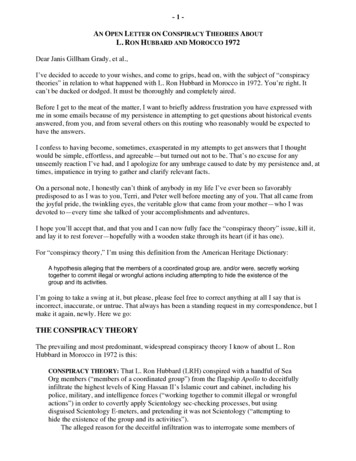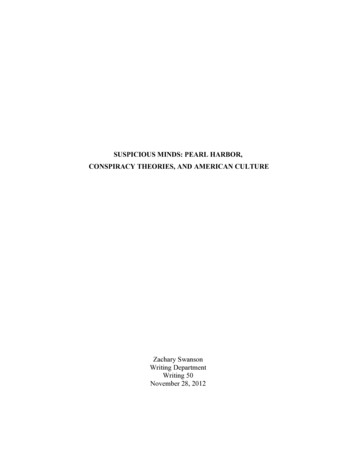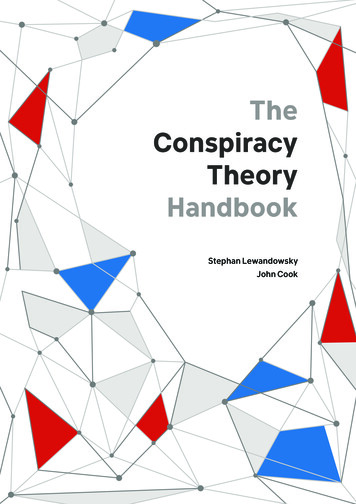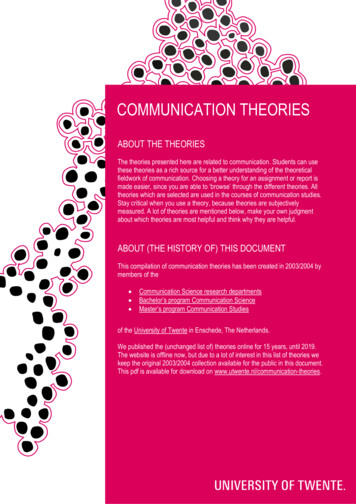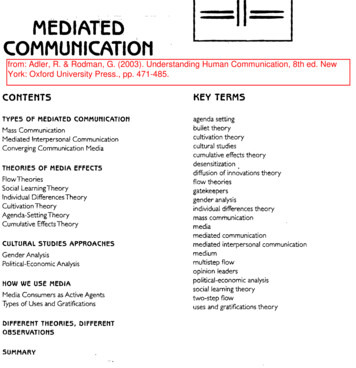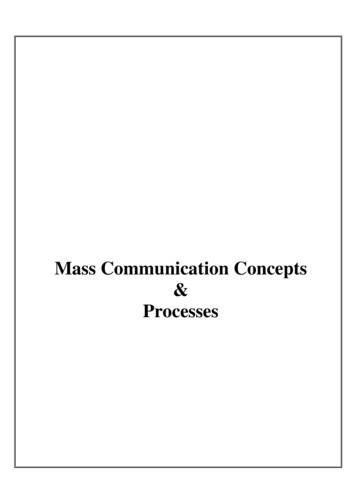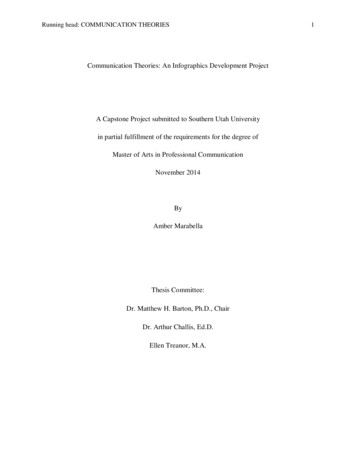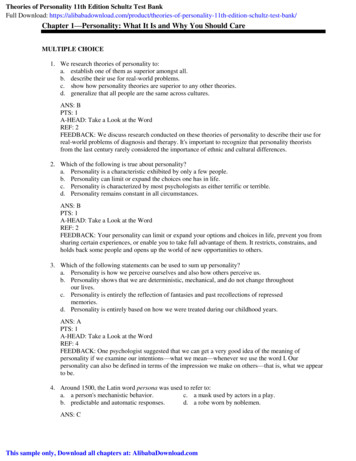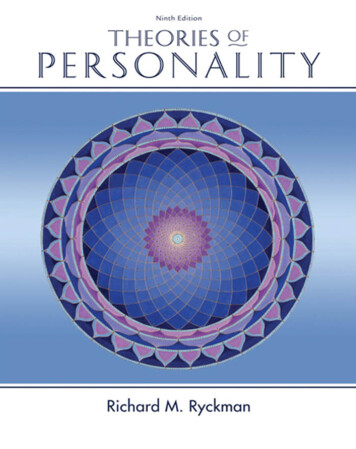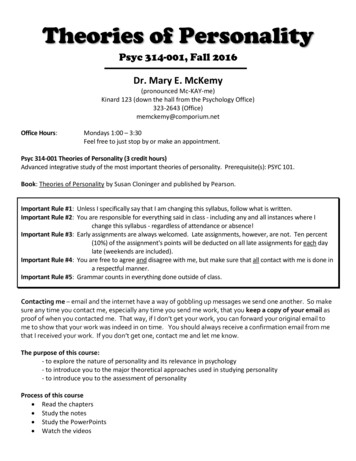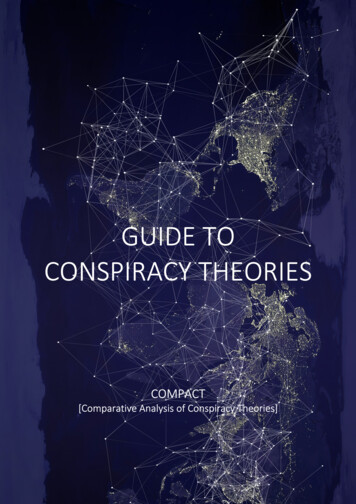
Transcription
Conspiracy theories: guide and recommendationsGUIDE TOCONSPIRACY THEORIESCOMPACT[Comparative Analysis of Conspiracy Theories]1
COMPACT [Comparative Analysis of Conspiracy Theories] is an EU-funded COST Action researchnetwork of 150 scholars from across Europe who are investigating the causes and consequences ofconspiracy theories. For more information: www.conspiracytheories.euAuthor:COMPACT Education GroupAcknowledgements:Michael Butter, Ela Drążkiewicz, Asbjørn Dyrendal, Jaron Harambam, Daniel Jolley, Olivier Klein,Peter Knight, Péter Krekó, Stephan Lewandowsky, Claus OberhauserDesign:Peter KnightDownload:This report is available to download from: www.conspiracytheories.euA full-length version of the recommendations section (“The Conspiracy Theory Handbook,”authored by Stephan Lewandowsky and John Cook) can be downloaded fromhttp://sks.to/conspiracyMarch 2020Published under a Creative Commons License (CC BY-NC-SA 4.0)Image: by Pete Linforth from Pixabay1
Conspiracy theories: guide and recommendations2
Conspiracy theories: guide and recommendationsTable of contents1UNDERSTANDING CONSPIRACY THEORIES41.1What is a conspiracy theory?41.2Are conspiracy theories the same as fake news?41.3Was the term “conspiracy theory” invented by the CIA?51.4How do conspiracy theories work?51.5What’s the difference between conspiracy theories and real conspiracies?51.6Who believes in conspiracy theories?61.7Why do people believe in conspiracy theories?71.8How have conspiracy theories developed over time?81.9What’s the effect of the internet on conspiracy theories?81.10Are conspiracy theories dangerous?91.11How are conspiracy theories and populism related?9SUGGESTIONS FOR FURTHER READING10211RECOMMENDATIONS FOR DEALING WITH CONSPIRACY THEORIES2.1Why are conspiracy theories so challenging?112.2Recognise that conspiracy theories are not irrational but political122.3Containing the spread of conspiracy theories122.4Inoculating against conspiracy theories122.5Debunking conspiracy theories132.6Protecting the public against conspiracy theories142.7When debunking fails: committed conspiracy theorists142.8Lessons from deradicalization programmes14REFERENCES163
Conspiracy theories: guide and recommendations1 Understanding conspiracy theoriesConspiracy theories – the belief that events are secretly manipulated behind the scenes bypowerful forces – exist in all modern societies. Over the past twenty years, their significance andpopularity has been increasing steadily, especially online. Some conspiracy theories may beharmless entertainment or a sign of well-founded scepticism. But at times they can be dangerous.They can lead to a loss of faith in medical and scientific expertise, to political disengagement, andeven to violence. Conspiracy theories are therefore a challenge for a broad variety ofstakeholders. This short guide provides an overview of the phenomenon.1.1 What is a conspiracy theory?Conspiracy theories assume that nothing happens by accident, that nothing is as it seems, andthat everything is connected. In other words, they claim that a group of evil agents, theconspirators, is secretly orchestrating everything that happens. They usually present the imaginedconspirators as enemies of the people. Conspiracy theories thus firmly divide the world into goodand evil, into Us vs. Them, leaving no room for doubt or complexity. They claim that you need tolook beneath the surface to detect the actions and intentions of the conspirators, who makegreat efforts to hide their wicked purposes. Conspiracy theories also usually see themselves assubverting received opinion. The assumption is that if you dig deep enough, you will find hiddenconnections between people, institutions and events that explain what is really going on. Theseassumptions put conspiracy theories at odds with the modern social sciences which stress theimportance of coincidence, contingency and unintended consequences. Conspiracy theoriessuggest that historical events are always the result of deliberate plotting, rather than impersonalsocial forces and structural effects. However, conspiracy theories usually do not spring fromnowhere. Often they are responses – albeit simplified and distorted – to genuine problems andanxieties in society.1.2 Are conspiracy theories the same as fake news?No, but they are often treated as identical in public discussions of fake news. Strictly speaking,however, there are differences. First, not all fake news claims that a sinister plot is going on.Second, the producers of disinformation know that they are spreading lies. They do sointentionally to create confusion, mobilize their audience, or smear opponents. By contrast, thevast majority of those who articulate conspiracy theories genuinely believe what they are saying.They are convinced that they are helping to reveal the truth. However, there also those whospread conspiracy theories that they do not necessarily believe in themselves in order to make4
Conspiracy theories: guide and recommendationsmoney and/or to achieve certain political goals. Especially in the age of the internet, some peoplehave profited from spreading conspiracy theories that they most likely do not fully believe inthemselves. Likewise, populist politicians often use conspiracy theories strategically in order tomobilise their followers. In these cases, conspiracy theories and fake news are indeed identical.1.3 Was the term “conspiracy theory” invented by the CIA?There is a conspiracy theory that claims that the CIA invented the term “conspiracy theory” todisqualify criticism of the official version of the Kennedy assassination. It is true that a claim that islabelled a “conspiracy theory” usually implies that it has no foundation in reality, that it does notwarrant further discussion, and that those who believe in it have a blurred perception of realityand might even suffer from severe psychological problems. The term thus is a potentiallypowerful insult. However, the CIA did not invent the term. The phrase is first used in its modernsense shortly after World War II by the philosopher of science Karl Popper, and since the 1960s ithas been increasingly used in everyday discourse.1.4 How do conspiracy theories work?Since they assume that nothing happens by accident, conspiracy theorists usually ask, “Whobenefits?” from a particular event, such as 9/11, or development, such as the refugee crisis. Aconspiracy theory often makes the leap from the idea that a particular group might havebenefited from an action to claiming that group must have secretly planned to bring it about.Conspiracy theorists then resort to one or both of two rhetorical strategies. Some of themarticulate their theory by explicitly trying to provide evidence that confirms their position, whileignoring all counterevidence. Others proceed more indirectly by trying to poke holes into theofficial version of events. The latter strategy has been particularly prominent in the western worldin the past decades because conspiracy theories often set themselves up as a challenge toreceived wisdom (things are more complicated now that, for example, the US president openlyengages in conspiracy speculation). The rhetoric of “just asking questions” allows conspiracytheorists to deny that they are actually spreading conspiracy theories. However, their questionsare usually designed to leave the conclusion that there must have been a conspiracy.1.5 What’s the difference between conspiracy theories and real conspiracies?There always have been and there always will be real conspiracies. However, real conspiracies –plots and schemes whose existence has been established beyond reasonable doubt – usuallydiffer from the conspiracies imagined by conspiracy theorists in several ways:5
Conspiracy theories: guide and recommendations Successful real conspiracies are usually event conspiracies. Compared to the typicalscenarios of conspiracy theories, they have a clear and rather modest goal such as a coupd’état or an assassination. Some conspiracy theories also revolve around specific events,but many others are “system” or superconspiracy theories. They tend to claim thatspecific groups such as the Freemasons or the Illuminati have been secretly plottingthroughout history, or they claim that different groups, for example the Jews and theCommunists, are secretly collaborating in a master plot to control all events. Real conspiracies usually involve a limited number of people who participate knowingly orunwittingly in the plot. Conspiracy theories, by contrast, often claim (sometimes byimplication) that hundreds or thousands of people have been involved in the alleged plotand cover up. This is the case even in seemingly simple examples of single events, letalone extravagantly complicated superconspiracies supposedly lasting centuries. Fakingthe moon landing or an inside job to pull off the 9/11 attacks would have requiredthousands of helpers who worked perfectly together and kept silent until today. Suchscenarios are highly unlikely, if not impossible. Finally, real conspiracies usually have unintended consequences. They lead to outcomesnot foreseen by the conspirators. Conspiracy theories, by contrast, usually claim thateverything goes according to the conspirators’ plan. They hardly ever leave room forunintended consequences. The assassination of Julius Caesar in 44 BC is an example of atypical conspiracy. He was killed by a group of about 60 senators. As real conspiracies go,this is already a rather large group. Compared to what most conspiracy theories claim,however, it is tiny. The conspiracy achieved its short-term and modest goal: Caesar waskilled. However, it proved counterproductive with regard to its more grandiose long-termgoal, the preservation of the Roman Republic. It sparked a civil war that eventually led tothe establishment of the Roman Empire.1.6 Who believes in conspiracy theories?In the past, belief in conspiracy theories was often associated with paranoia and otherpsychological problems. And while some individual conspiracy theorists might well be paranoid,belief in such theories is far too wide-spread to be explained in terms of abnormal psychology.Some recent polls have even found that the majority of citizens in Europe and the US believe inone or more conspiracy theories. Psychological research, however, has found that people whofeel powerless or have trouble accepting uncertainty are particularly prone to believing inconspiracy theories. Some studies have also found that the likelihood of believing in conspiracy6
Conspiracy theories: guide and recommendationstheories decreases with the level of education. However, research shows that believers comefrom all ethnicities and walks of life. Most studies also do not find any significant differencebetween men and women. However, male conspiracy theorists often are more visible andoutspoken. The reason for this might be that conspiracy theories are a way to deal with thewidespread crisis of masculinity in the western world.1.7 Why do people believe in conspiracy theories?Conspiracy theories are attractive because they fulfil important functions for the personal, socialand political identity of those who believe in them. Conspiracy theories make the world meaningful because they exclude chaos andcoincidence. They also make the world intelligible because they provide a simplisticexplanation for political and social developments. They are a strategy for dealing withuncertainty and resolving ambiguity. It is easier for some people to accept that a group ofevildoers is secretly pulling the strings than to face the possibility that there is nobodypulling the strings and that sometimes things just happen. In this way, conspiracy theoriesfulfil similar functions to religion, providing both an explanation of how the world worksand a sense of personal identity and purpose. Conspiracy theories are thus oftenassociated with a tendency towards esoteric beliefs or “magical thinking.” Conspiracy theories blame people rather than abstract forces for political events anddevelopments in society. They are an important tool for what the social sciences call“othering”: they allow their believers to identity scapegoats and draw a firm line between“us” – the victims of the conspiracy” – and “them” – the conspirators. In this way,conspiracy theories can forge strong communal feelings. By the same token, they allowthose who believe in them to signal their group membership. For example, by expressinganti-vaccination conspiracy theories, people may indicate that they are part of thecommunity that believes in alternative medicine and follows an alternative life-style. Conspiracy theories relieve those who believe in them of responsibility. Since powerfulconspirators are blamed for everything that happens, the believers themselves cannothave had any impact on events and developments. Conspiracy theories allow those who believe in them to distinguish themselves from themass of people. Since conspiracy theories have come to be a stigmatized form ofknowledge in the western world in recent decades, it is no longer socially acceptable tobelieve in them. Those who believe in them can nevertheless take comfort from the idea7
Conspiracy theories: guide and recommendationsthat – unlike the rest of the population – they have woken up and understood what isreally going on. At times, conspiracy theories can also channel social discontent and criticism, for exampleof how public institutions function. They can be a means of political contestation and astrategy to rebel against authority (for example, that of parents, teachers, or elites), evenif they latch onto the wrong target.1.8 How have conspiracy theories developed over time?Conspiracy theories as defined above are not an anthropological given. They first emerged inEurope during the late Early Modern period, with important precursors in ancient Greece andRome. They were then “exported” to the rest of the world. From the late sixteenth until far intothe twentieth century, conspiracy theories were an accepted from of knowledge that wasbelieved and articulated by elites and ordinary people alike. Thus, conspiracy theories have notalways automatically been counter-narratives. Often the official explanation of events was itself aconspiracy theory. In the western world, conspiracy theories appear to have undergone a processof stigmatization in the second half of the twentieth century that turned them from officiallyaccepted into illegitimate knowledge. Outside of the western world, however, this stigmatizationhas not occurred. Accordingly, conspiracy theories are still considered legitimate knowledge in,for example, the Arab world or Russia, where they are articulated by experts, elected officials, themedia and academics.1.9 What’s the effect of the internet on conspiracy theories?We do not know yet if the internet has led to a massive or only a modest increase of belief inconspiracy theories. What is clear, however, is that it has made conspiracy theories more visibleand far more easily available, and it has greatly accelerated their circulation. The jury is still out onwhether the recommendation algorithms of platforms like YouTube quickly lead viewers downthe rabbit hole of ever more extreme content, or whether increased “demand” for alternativenarratives and conspiracy theories is more important than changes in the “supply” side. Researchhas shown that false rumours (about e.g. the Zika virus) spread far more quickly and widely thanfactual corrections. However, it is not clear whether circulating a conspiracy story necessarilyimplies endorsement of it; the rise of alt-right trolling has meant that conspiracy rumours areoften spread in order to provoke a reaction, rather than out of sincere belief. Like all previousmedia revolutions, the rise of the internet has also had a significant impact on the form ofconspiracy theories. Conspiracy theory videos on YouTube and other platforms are less dry than8
Conspiracy theories: guide and recommendationsthe books and pamphlets of earlier times. Moreover, platforms like Twitter that restrict thenumber of characters for a single post have led to shift from conspiracy theories to conspiracyrumours, because conspiracy speculations are increasingly circulated without the kind of evidenceand convoluted narratives that tended to accompany them in the past and in other media. Somecommentators have therefore suggested that we are now seeing an increase of “conspiracywithout the theory.”1.10 Are conspiracy theories dangerous?Not all conspiracy theories are dangerous; many are quite harmless. The context matters: whobelieves what, in which situation, and to what effect? Moreover, those conspiracy theories thattend to be problematic can be dangerous in different ways. Conspiracy theories can be a catalyst for polarisation and violence. Since they identify agroup, the conspirators, that is seen as responsible for all evil, those who believe in themmay feel justified or even obliged to act against this group, its institutions orrepresentatives. Conspiracy theories that challenge established medical knowledge – for example theclaim that scientists are concealing the fact that vaccinations cause autism or that the HIVvirus was manufactured in a biowarfare lab – can be dangerous because believers mayrefuse inoculation for themselves or their children or have unprotected sex. Conspiracy theories can lead to political apathy or fuel populism. People who believe thatelections are a sham because the different candidates are controlled by the sameevildoers are likely to either disengage from the political process, or to vote for populistparties that present themselves as the true alternative to a rotten political system.1.11 How are conspiracy theories and populism related?Supporters of populist parties and movements appear to be particularly receptive to conspiracytheories, and populist politicians frequently employ conspiracist rhetoric. This is because bothpopulism and conspiracy theory reduce the complex political field to a simple opposition: thepeople versus the elite, in the case of populism; and the victims of the conspiracy versus theconspirators, in the case of conspiracy theory. As an element of populist discourse, conspiracytheories offer a specific explanation why the elites act against the interests of the people. Thisaccount tends to co-exist within a populist movement or party with other explanations such asnegligence or personal enrichment. Hence, conspiracy theories are a non-necessary element of9
Conspiracy theories: guide and recommendationspopulist discourse and ideology, and they are not necessarily believed by everybody in thepopulist movement or party in which they are circulating.Suggestions for further readingBartlett, J. and Miller, C. (2010) The Power of Unreason: Conspiracy Theories, Counter-terrorismand Extremism, asonBergmann, E. (2018) Conspiracy and Populism: The Politics of Misinformation. Palgrave Macmillan.Borenstein, E. (2019) Plots Against Russia: Conspiracy and Fantasy After Socialism. CornellUniversity Press.Brotherton, R. (2015) Suspicious Minds: Why We Believe Conspiracy Theories. Bloomsbury.Butter, M. and Knight, P. (eds) (2020) The Routledge Handbook of Conspiracy Theories. Routledge.Butter, M. (2020) The Nature of Conspiracy Theories. Polity Press.Byford, J. (2011) Conspiracy Theories: A Critical Introduction. Palgrave Macmillan.Douglas, K. et al. (2019) ‘Understanding conspiracy theories’. Political Psychology 40, 3-35.Harambam, J. (2020) Contemporary Conspiracy Culture: Truth and Knowledge in an Age ofEpistemic Instability. London: Routledge.Merlan, A. (2019) Republic of Lies: American Conspiracy Theorists and Their Surprising Rise toPower. Random House.Olmsted, K. (2009/2019) Real Enemies: Conspiracy Theories and American Democracy, World WarI to 9/11. Oxford University Press.Qassam, C. (2019) Conspiracy Theories. Polity Press.Uscinski, J. (2018) (ed.) Conspiracy Theories and the People Who Believe Them. Oxford UniversityPress.Uscinski, J. and Parent, J. (2014) American Conspiracy Theories. Oxford University Press.van Prooijen, J-W. (2018) The Psychology of Conspiracy Theories. Routledge.10
Conspiracy theories: guide and recommendations2 Recommendations for dealing with conspiracy theories2.1 Why are conspiracy theories so challenging?Real conspiracies do exist, and they are typically revealed by whistle-blowers or media.Conspiracy theories, by contrast, are attempts to explain a prominent event – even the entirecourse of history – in terms of the plotting of a powerful but hidden cabal. These conjectures areoften highly speculative. Typically, conspiracy theories are not supported by evidence thatsurvives conventional scrutiny, although the lack of evidence does not prevent a theory fromblossoming. Communication efforts that seek to debunk conspiracy theories are challenging for atleast two reasons: Contrary to the media stereotypes, people who engage with conspiracy theories are notall the same, and the role that conspiracy theories play in their lives can differ greatly.Sometimes, conspiracy theories can be a way of expressing opposition, or can be part ofwhat creates a sense of group identity. We therefore need to understand why thesebeliefs matter to those who hold them. Belief in conspiracy theories is not usually the result of a lack of knowledge (after all, inthe age of the internet we have easy access to unprecedented amounts of information).Often, conspiracy theories can’t simply be “corrected” by providing additional evidence.Instead we need to understand more about why many people today feel resentmenttowards the very idea of expert knowledge. A defining attribute of conspiracy theories is thus that they are “self-sealing,” i.e. peoplewho strongly believe in conspiracy theories often interpret any attempt to providecontrary evidence as evidence for the conspiracy. Although sometimes conspiracytheories result from not much more than a general sense of scepticism (“this alternativeversion of events might be true, for all I know”), in other cases conspiracy theorists are sodeeply invested in a particular world view that their beliefs can be very hard to debunk. There is evidence that mere exposure to a conspiracy theory can have adverseconsequences, even among people who do not subscribe to the conspiracy theory (e.g.Einstein and Glick 2015; van der Linden 2015; Jolley et al. 2019). Conspiracy theories are also often associated with political extremism (van Prooijen et al.2015) and disengagement.These challenges suggest that communication efforts must differentiate between differentaudiences, and understand how conspiracy theories work in particular individual, social and11
Conspiracy theories: guide and recommendationspolitical contexts. There is no single, simple solution to the problem of conspiracy theories, andthe following recommendations are therefore grouped by target audience.2.2 Recognise that conspiracy theories are not irrational but politicalAlthough conspiracist talk is often characterized by flaws in reasoning, it does not follow thatpeople who articulate or believe conspiracy theories are necessarily irrational. Instead there isevidence that conspiracy theories are deployed as a rhetorical tool to escape inconvenientconclusions, to bolster their sense of identity, or to promote particular political positions,including state-sponsored disinformation (Yablokov 2015). For example, climate change denialoften involves holding mutually exclusive positions (such as the simultaneous claims that (a)temperature cannot be measured accurately but (b) global temperatures have declined;Lewandowsky et al. 2016). Logical inconsistency might be a common trait of conspiracy thinking,but dismissing climate denial as merely irrational doesn’t explain why this belief matters to thepeople who hold it, and why they are so resistant to challenge on factual grounds.2.3 Containing the spread of conspiracy theoriesSocial media has created a world in which a person with no track record or reputation can reachas many consumers as mainstream TV and print media. Using digital media to counter the spreadof conspiracy theories is under development but has not yet been deployed on a large scale.However, relatively simple psychological interventions are promising. For example, one studyshowed that the sharing of conspiratorial climate-denial posts on Facebook was reduced by asimple intervention that encouraged people to ask four questions about material before sharing it(Lutzke et al. 2019): Do I recognize the news organization that posted the story? Does the information in the post seem believable? Is the post written in a style that I expect from a professional news organization? Is the post politically motivated?2.4 Inoculating against conspiracy theoriesAnother way to protect the public is to alert them to the nature of conspiracy theories beforethey are encountered. This process is known as “inoculation” or “prebunking.” There are twoelements to an inoculation: (1) an explicit warning of an impending threat and (2) a refutation ofan anticipated argument that exposes the imminent fallacy. In one experiment involving antivaccination conspiracy theories (Jolley and Douglas 2017), the researchers found that when12
Conspiracy theories: guide and recommendationspeople were inoculated by first receiving the anti-conspiratorial material, they were no longeradversely affected by the conspiracy theory. By contrast, if the conspiratorial material waspresented first, the countering material was less effective. The conclusion is that it is vital to makepeople aware of the flawed reasoning that characterizes conspiracy theories. It must be noted,however, that inoculation only immunizes against specific conspiracy theories and not generally.We also need to remember that many believers in conspiracy theories are sceptical about thevery idea of expert knowledge and rational argument.2.5 Debunking conspiracy theoriesAfter containing and inoculating, debunking is the next best option. Research has shown thatexposure to conspiracy theory increases historical misconceptions, but corrections with evidencedecreases them (Nyhan and Zeitzoff 2017). With participants who are not committed conspiracytheorists, debunking has been shown to be partially effective, including: evidence-based counter-messages (Warner and Neville-Shepard 2014) rebuttal messages (Schmid and Betsch 2019) algorithmic and user-generated corrections (Bode and Vraga 2018)However, other strategies have been less effective: Ridiculing conspiracy theories can significantly reduce acceptance of a theory but runsthe risk of being automatically rejected (Orosz et al. 2016). The same is true for counter-messages that aggressively deconstruct or that focus on“winning” an argument (Schmitt et al. 2018). Showing compassion to those who believe in conspiracy theories is less successful (Oroszet al. 2016).Anti-vaccination conspiracy theoriesIn a large series of studies using representative samples of participants, Schmid andBetsch (2019) showed that conspiratorial denial of the efficacy and safety ofvaccinations can be reduced by rebuttal messages. When an appeal to a profitmaximizing conspiracy between government and the pharmaceutical industry was leftunchallenged, people’s intention to vaccinate and their attitude towards vaccinationsdeclined significantly. By contrast, when the conspiracy was rebutted either byhighlighting the misleading techniques employed by conspiracy theorists (e.g., bypointing out that much of the research in support of vaccinations has been conductedby independent, publicly-funded scientists), or by correcting false assertions (e.g., byemphasizing how vaccinations improve public health), then exposure to the conspiracytheory no longer had an effect. The study found that each rebuttal technique –pointing to flawed reasoning or providing facts – on its own was equally effective, butthat a combination of both did not provide additional persuasive power.13
Conspiracy theories: guide and recommendations2.6 Protecting the public against conspiracy theoriesSince endorsing conspiracy theories is caused by feelings of reduced control and perceived threat(Uscinski and Parent, 2014), the following options make sense: If people’s sense of control is primed (e.g., by recalling an event from their lives that theyhad control over), then their endorsement of a potential conspiracy theory is reduced(van Prooijen and Acker 2015). Citizens’ general feeling of empowerment is improved when authorities are seen tofollow fair decision-making procedures (van Prooijen 2018). People should be encouraged to think analytically, rather than rely on intuition (Swami etal. 2014).2.7 When debunking fails: committed conspiracy theoristsDebunking is much more challenging with committed individuals who are devoted to one or moreconspiracy theories. People who believe in one conspiracy theory often believe in many, as theyview all history and politics through the lens of conspiracy. Online environments now create echochambers and filter bubbles. One research study showed that those with firmly entrenchedconspiracy beliefs who interacted with the debunking material ended up even more engagedwithin their conspiracy theory echo chamber afterwards (Zollo 2017). They were more likely tostop interacting with conspiracy news if they were not exposed to debunking. In these cases,debunking might well make things worse. In these online environments, individual posters canhave a disproportionate influence, and can be hard to reach. A recent study (Klein et al. 2018)showed that on the main Reddit site dedicated to conspiracy theories only about 5% of posterswere responsible for two thirds of all comments, with the most active aut
Conspiracy theories thus firmly divide the world into good and evil, into Us vs. Them, leaving no room for doubt or complexity. They claim that you need to look beneath the surface to detect the actions and intentions of the conspirators, who make great efforts to hide their wicked purposes. Conspiracy theories also usually see themselves as
